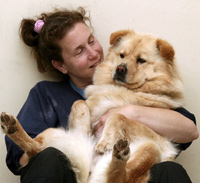Brake for Wildlife
Take Care Not to Injure Animals Crossing the Road
Animals pay the price for our growing population; as the number of people continues to climb, so does the number of highways and roadways. Spring is breeding season for wildlife and the urge to mate results in more animals on the move. The math is sadly simple–more animals on or near roads, equal more animals injured or killed by automobiles. Springtime means more baby animals who inadvertently cross roadways. This past weekend alone I counted more than seven dead skunks on Barbara roads.

According to the Federal Highway Administration, when highways fragment landscapes, they divide wildlife populations into smaller, more isolated units. Animals will instinctively return to their native breeding grounds, regardless of what is in the way, including roads; resulting in millions of animals that die each year in their attempt to cross the road in search of food or a mate.
The Humane Society of the United States and the Urban Wildlife Research Center have arrived at a conservative figure of one million animals killed each day on highways in the United States. These statistics do not account for animals that crawl off the road to die after being hit.
Whether you are driving to work, on vacation, running errands, or enjoying a spring drive, take a few moments to consider the effect you may have on wildlife. By driving more carefully, we can help minimize the needless deaths of many innocent creatures. Keep these helpful hints in mind:
Be Alert
*Always pay attention to your driving and avoid talking on your cell phone and fiddling with the radio.
*As you drive, scan the road ahead and be aware of animals that may dart into your path.
*Dawn and dusk are prime times when many species of wildlife are most active, so pay careful attention during these times.
*Many young animals have not yet learned to be afraid of people or cars and don’t move quickly out of the way. If you see an animal in your path, don’t just assume that it knows to get out of the way.
*Look for the reflection of your headlights in the eyes of animals near the road as an early warning that you may need to brake for an animal crossing.
*Remember to watch for other animals following the first one you see; there may be a male in pursuit of a mate or young animals following their mother.
*Edges of roads that border agricultural fields or natural habitats are places to be particularly watchful for wildlife.
*Never throw food, food wrappers, or food containers along roads. Not only is littering illegal, it also lures animals to the side of the road and increases their risks of getting hit.
Slow Down
High speeds pose a risk to animals as well as humans, so please slow down for everyone’s sake. Besides, slowing down improves your gas mileage so you’ll be polluting less and saving money!
If an Animal is Hit
*First, do not do anything that puts your own safety at risk. Unless you can move an animal out of the road safely, do not attempt it.
*If you decide to move an injured animal, put on your emergency car lights to warn oncoming traffic.
*Do not handle the animal directly; it could bite out of fear or pain.
*Use heavy gloves or a towel and try to place the animal in a box or other suitable carrier. *Take the animal to a shelter or a wildlife rehabilitator.
*Call animal control if you injure an animal that can inflict a serious bite, such as a raccoon or if you see an injured animal on the side of the road.
Local Resources
Santa Barbara Wildlife Care Network: 805-966-9005
Marine Mammal Center: 805-687-3255
Santa Barbara City Animal Control: 805-963-1513
Santa Barbara County Animal Control: 805-681-5285
Print out this column and put it in your glove box so you have these numbers handy in the event of an emergency.
Aside from driving safely when it comes to wildlife, you should always drive carefully when it comes to other drivers, pedestrians, bikers, etc. I believe every driver should take the “no-phone zone” pledge. Studies have shown that even in states such as California, where only hands-free phone devices are allowed while driving, accidents due to cell phone usage are still the same. As Oprah Winfrey says, “It’s not where your hands are, it’s where your head is.” So take the no-phone zone pledge today. For more information, visit: www.oprah.com/packages/no-phone-zone.html
Giving wildlife a “brake” not only saves their lives, it could also save yours. Enjoy the season, but drive with wildlife in mind!
Adoptable Pet of the Week
Kira is a one-year-old spayed female chow/golden retriever mix weighing in at 50 lbs. She is not enjoying the shelter too much, but once she gets out on the front lawn she transforms into a bouncy, playful, affectionate clown. Kira lacks the aloofness of a chow, and acts mostly like a golden retriever. She is also a good snuggler! Kira would make a fine family dog.
She is awaiting a home at DAWG, 5480 Overpass, Goleta; 681-0561. dawgadopt@yahoo.com. For more info and more adoptable dogs, see www.sbdawg.com/



